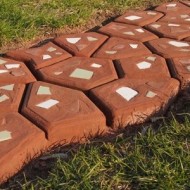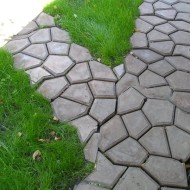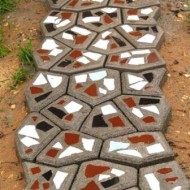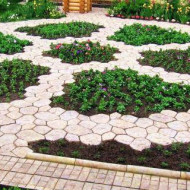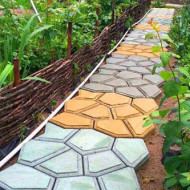Economical solution: we build a garden path with our own hands using a form
Content
Technology advantages
Paved garden paths connect all the significant functional objects that are located on the territory of the personal plot. Such paths make the suburban area more harmonious and aesthetically attractive. For paving paths, you can use various building and improvised materials: natural wood boards, pressed wood panels, plastic panels, natural and artificial stone, paving stones, paving slabs.
The cheapest way to arrange paths in the garden is to fill the site with concrete. However, the track, complemented by a pattern or a certain pattern, looks much more interesting and attractive. For this reason, cobblestone paths are very popular among summer residents. Alternatively, it is recommended to use slabs made with special shapes.
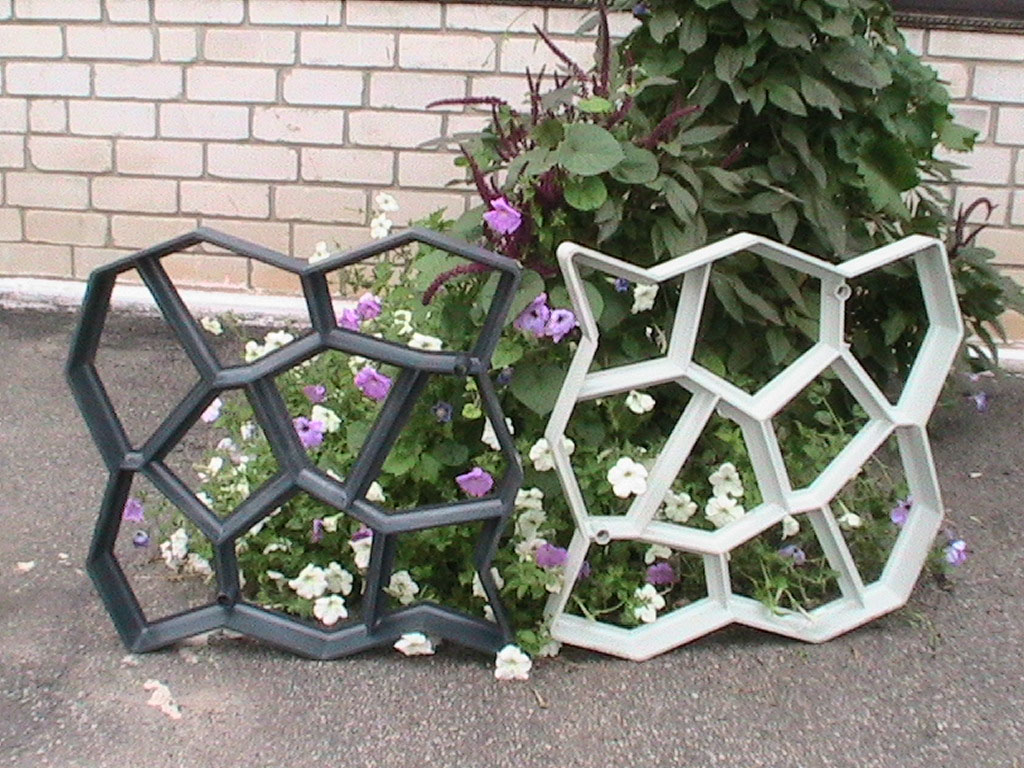
The advantages of the form for arranging paths in the country include:
- low cost of building material;
- lack of binding to transport companies that are engaged in unloading and loading operations and delivery of building materials;
- ease of installation;
- no difficulties during the operation of the finished structure;
- a wide selection of stencils that differ in size and configuration;
- the ability to make stencils with your own hands.
A do-it-yourself garden path using special shapes looks very organic and interesting. You can increase the attractiveness of such a path by adding pebbles, marble chips or broken organic glass to the solution.
Video "Laying paths in the garden"
This video describes how the concreting of a garden path takes place using special stencils.
Varieties
Many are wondering where to find a mold for making homemade tiles. Ready-made templates, which professional builders call matrices, are sold in almost every hardware store. A wide assortment is offered to the attention of buyers. Forms differ in size, configuration and material of manufacture.
Silicone models are considered the most durable and durable. Silicone stencils hold their shape well, wash well, and are easy to use. Plastic dies are a more budget-friendly option for a ready-made stencil. As for the pattern, the finished shapes are round, oval, square, rectangular and non-standard.
How to make a form yourself
It is not necessary to buy ready-made stencils in stores, you can make such a shape yourself. Hoops removed from barrels, wooden beams and slats, curved metal sheets are used as a basis.
The easiest way to make a homemade mold for casting paving slabs:
- Take wooden beams with a cross section of 50x50 cm. Form a frame in the form of a square or rectangle.
- Secure the joints between the bars with metal corners.
- Using slats with a cross section of 30x30 cm, make internal jumpers.
Homemade stencils are distinguished by their originality and unique configurations. Garden paths, in the process of laying which they use self-made forms, have no analogues.
Construction of paths
Now let's talk about how to make paths in the country using stencils.
First you need to pick up a construction tool and make a purchase of all the necessary materials. To pour a solid and durable base, you need to choose high-quality cement. So, for the manufacture of paving slabs, it is recommended to take cement of the M-500 brand.
At the next stage, the garden plot is divided into sectors and the foundation is prepared. The beginning of the path is marked with a wooden peg. The rest of the guides are installed with a step of 1.5–2.5 m; in places of bends, the distance between the pegs should be no more than 1.5 m.
Preparation of the base
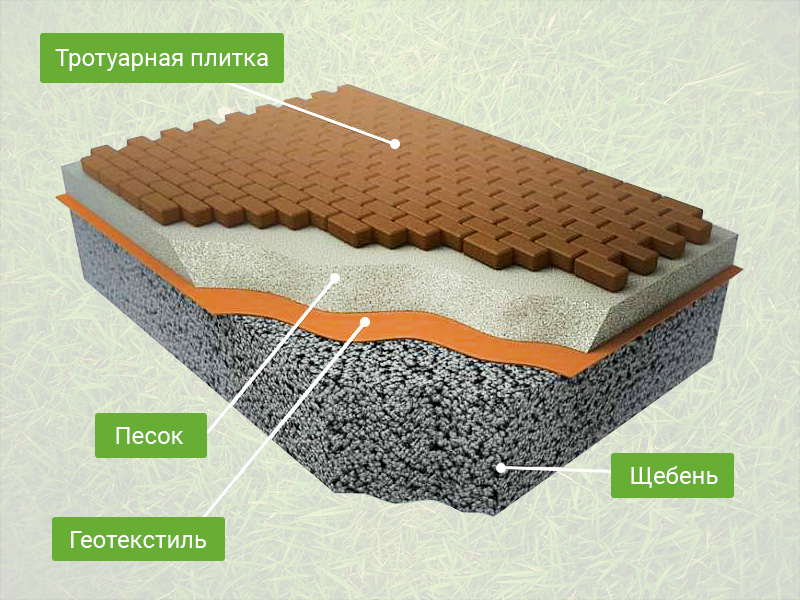
Using bayonet and shovels, make indentations along the marking line and remove the top layer of the earth. When the trench is ready, the foundation is laid. River coarse sand, crushed stone, geotextile fabric and dry cement are used as a base pillow. Geotextile acts as a drainage system and prevents the structure from sinking during its operation.
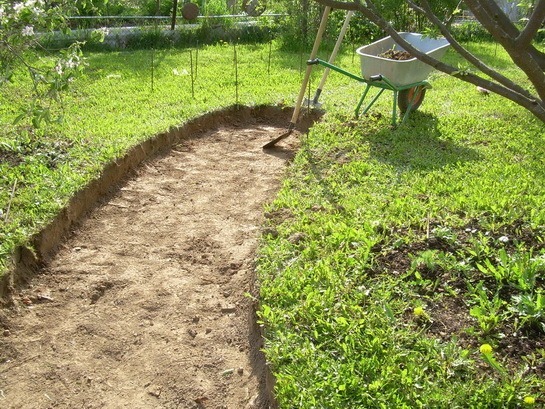
Each layer of the base is carefully compacted and leveled with special tamping equipment.
Pouring concrete
Once you've finished preparing your base pillow, you're ready to start pouring the shapes. The first step is to form a formwork or install a curb that prevents the spread of the concrete solution.
Forms for pouring the solution are laid out on the previously prepared base. Crushed stone is poured inside each stencil and concrete mortar is poured. The surface is carefully leveled with a trowel. After 40-50 minutes, the stencils are removed and the filling of the following elements is continued.
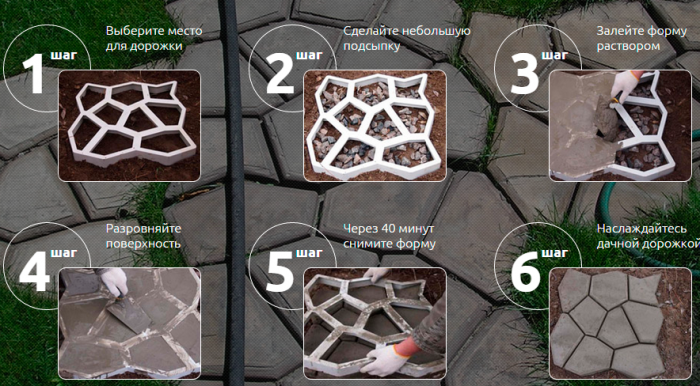
Sealing of seams
At the last stage, the joints are filled. If the tiles are located end-to-end, it is recommended to grout the joints with a dry cement-sand mixture. To prepare such a mixture, you will need sand and cement in a ratio of 4: 1. The dry solution is applied in an even layer to the finished surface and watered with water. After the surface of the path is completely dry, you should re-fill the inter-row slots with dry mortar.
The procedure for sealing joints with a dry cement-sand mixture must be repeated 3-4 times with an interval of 4-5 days. It is not necessary to seal the joints between the slabs in rainy weather, as the probability of uneven filling and partial subsidence of the grout increases.

Colored seams look more interesting and original. To make a multi-colored grout, you can use special dry colors. When choosing a material, it is recommended to pay attention to the composition of the dye and its technical characteristics.
Moisture-resistant compounds are suitable for the design of street paths.
Useful Tips
Simple concrete paths in the garden have become so commonplace that every summer resident wants something more interesting and unusual. Why not add dye to the solution and make a bright path in the garden? The multi-colored paths on the territory of the personal plot look bright and impressive.
The lawn grass planted between the slabs will give the path a certain identity and attractiveness. The slabs, complemented by a variety of patterns, drawings and even footprints and handprints, also look interesting.
A garden path in the garden using stencils is an excellent opportunity to equip the territory of a personal plot without unnecessary investment. A variety of sizes and configurations of stencils allows you to realize any ideas and ideas of the summer resident.

